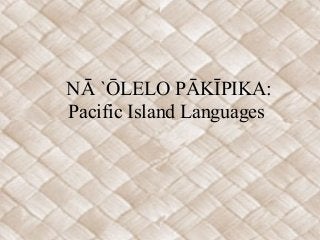
Na olelo pakipika
- 1. NĀ `ŌLELO PĀKĪPIKA: Pacific Island Languages
- 2. NĀ `ŌLEO PĀ KĪ PIKA • 20% of the world’s languages • Approximately 1,000 indigenous languages for a population of less than 10 million • Other languages of the world were introduced with the arrival of Europeans and as Pacific Islanders traveled around the world
- 3. TAHITIAN • A E F H I M N O P R T U V ` `ā `ē fā hē `ī mō nū `ō pī rō tī `ū vī `eta • ` = `eta (glottal stop) • - = tārava (macron that marks long vowels) • Like Hawaiian, every word ends in a vowel and there are no consonant clusters
- 4. MĀ ORI • 5 vowels – a, e, i , o, u (also has long versions: ā, ē, ī , ō, ū) • 10 consontants – p, t, k, m, n, ng, wh, r, h, w • For more on how to pronounce the alphabet, click here
- 5. SĀ MOAN • a, e, i, o, u • f, g, l, m, n, p, s, t, v, h, k • Vowels can be short or long. Long vowels are marked with a macron. • Like Hawaiian and Tahitian, every word ends in a vowel and there are no consonant clusters • For more on how to pronounce the alphabet, click here
- 6. COMPARISON OF WORDS ENGLISH HAWAIIAN TAHITIAN MĀORI SĀMOAN COOK ISLANDS Eye maka mata mata mata mata Woman wahine vahine wahine fafine va`ine Bag `eke `ete kete `ato kete Sky lani ra`i rangi lagi rangi Hand lima rima ringa lima rima Sea kai miti tai sami tai Canoe wa`a va`a vaka Va`a vaka
- 7. COMPARISON OF NUMBERS ENGLISH HAWAIIAN TAHITIAN SĀMOAN MĀORI one `ekahi tahi tasi tahi two `elua piti lua rua three `ekolu toru tolu toru four `ehā maha fa wha five `elima pae lima rima six `eono ono ono ono seven `ehiku hitu fitu whitu eight `ewalu va`u valu waru nine `eiwa iva iva iwa ten `umi `ahuru sefulu tekau
- 8. If you have any questions, please ask them on the Discussion Board. Mahalo!
Notes de l'éditeur
- Language is an essential component in the development and transmission of human culture, society, identity and belief. Although there are many competing schools of thought regarding the origins of language in the human species, most agree that language capability is one of the most distinguishing characteristics separating human beings from the rest of the worldʻs species and is the root of culture, history and tradition. The languages spoken in Oceania constitute almost 20% of the worldʻs languages with approximately 1,000 indigenous languages for a population of less than 10 million. For Hawaiian people and many other societies in Oceania, the spoken word is extremely important ,as it is powerful. Words have the power to heal as well as harm and carelessness can result in detrimental effects
- Tahiti is the largest island in the Windward group of French Polynesia, located in the archipelago of the Society Islands. French and Tahitian are the official languages and both are commonly used. English is also widely understood in tourist areas. Tahitian, Reo Ma`ohi or Reo Tahiti, is an indigenous language spoken mainly in the Society Islands in French Polynesia. Until the early 19 th century, Tahitian was purely an oral language.
- Te Reo Māori is the language of the indigenous people of Aotearoa or New Zealand. By the mid-20 th century, there were concerns that the language was dying out. Like the `ōlelo Hawai`i, the Māori language was suppressed in schools, either formally or informally, so that Māori youngsters could assimilate with the wider community. Some older Māori still recall being punished for speaking their language. By the 1920’s only a few private schools still taught Māori grammar as a school subject. Many Māori parents encouraged their children to learn English and even to turn away from other aspects of Māori custom. By the 1980’s, less than 20% of Māori knew enough of the language to be regarded as native speakers. Even for those people, Māori was ceasing to be the language of every day use in the home. From the 1970’s, many Māori people reasserted their identity as Māori. An emphasis on the language as an integral part of Māori culture was cental to this. Māori leaders were increasingly recognizing the dangers of the loss of the Māori language. New groups emerged and made a commitment to strengthening Māori culture and the language. Māori language day became Māori language week in 1975. Major Māori language recovery programs began in the 1980’s. Many were targeted at young people and the education system. The kohanga reo movement, which immersed Māori preschoolers in the Māori language, began in 1982 and other programs followed suit. Māori became an official language with the passing of the Māori Language Act in 1987. Thus, most government departments and agencies and buildings have bilingual names and signs.
- Sāmoan is the official language, along with English, of the Sāmoan Islands.
- . Regular sound correspondence between K in Hawaiian with t in other Polynesian languages. Linguistic analysis of Hawaiian supports a theory that the language has its closest relatives in the Marquesas, Society, and other island groups of French Polynesia, some 2000 miles to the south.